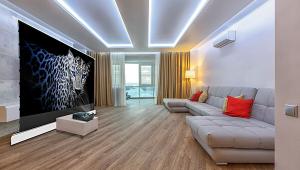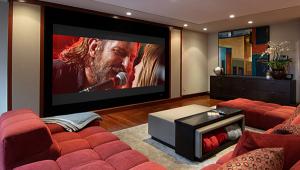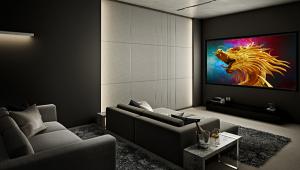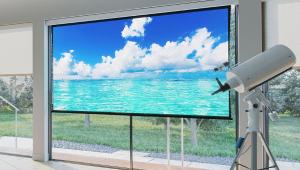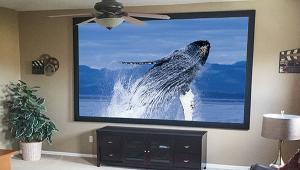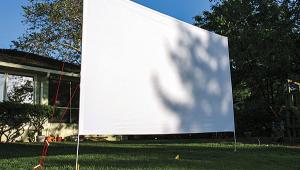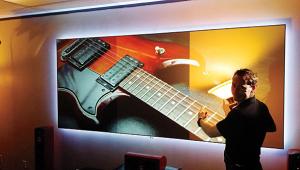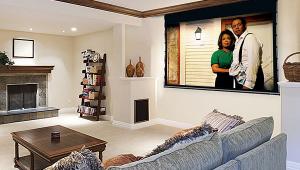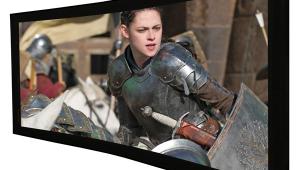Stewart Filmscreen Harmony G2 Acoustically Transparent Screen Review Page 2
The terrific folks at Epson graciously provided a Home Cinema 5050UB 3LCD projector, a highly effective screen evaluation tool, to use for my test. I positioned the 5050UB inside a shelving system, its lens height aligned with the center of the Harmony G2 for the best possible performance. The screen's delivery coincided with the start of the Stanley Cup playoffs, and for the first few days I left the Epson in Natural, a picture mode that tracks very close to the Rec.709 standard at factory default and set the lamp mode to Eco since the image was plenty bright.
Performance
After a bit of pre-game warm up, I settled in for some viewing. Note-taking almost instantly ensued: "Fantastic detail, wonderful edge-to-edge uniformity, no motion artifacts in any trajectory." Hockey match broadcasts can present unique on-the-fly tests for any video system. Does the ice look white? Do artifacts arise when players whir past advertising on the "boards" tracked by rapid camera pans? In hundreds of Epson calibrations (professional video calibration is my day job), I've found the on-board motion processing of the company's projectors to be very well-executed, leading me to conclude if nothing on a screen is visibly amiss when it's paired with a top-range Epson, the screen is free of anomalies.
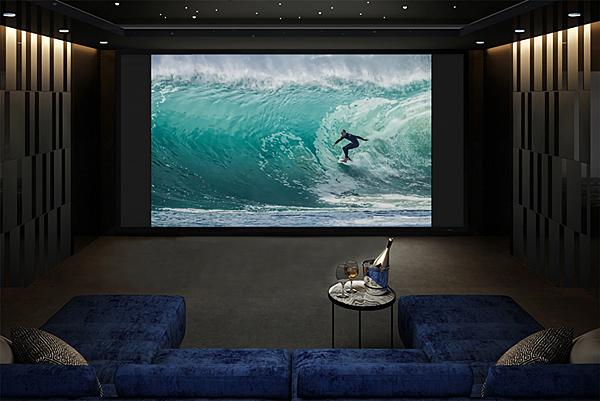
I continued to scrutinize the Harmony G2 for any sign of visual weakness, discovering nothing the closer I peered. Streamed from Hulu via Apple TV, 4K coverage of Formula 1 auto racing by Sky Sports (downconverted and presented on ESPN) looked magnificent. Referencing my viewing notes a few days later, I had graphically circled a group of sentences describing the stunning portrayal of carbon fiber layers within a labyrinth of unpainted, deftly staggered elements comprising an unpainted Mercedes front wing assembly. The fiber pattern looked like the outline of every tile in a completed 1,000-piece puzzle. During these cursory sessions, in no instance did I detect the underlying weave of the Harmony G2 fabric.
Viewing from eight feet away, I scribbled "every intricate, subordinate part of the image is finely chiseled, and retained in motion." While light output in the Epson's Natural mode was only 11.6 footlamberts (ft-L), that proved to be plenty for my viewing distance and environment. Checking out test material after calibrating the projector, I felt nothing more was needed, but one task remained.
After further calibrating the Epson's Bright Cinema mode to reach the SMPTE 16 ft-L/ Rec.709 cinema target, I could not think of a more appropriate Ultra HD movie to watch than La La Land, an established reference quality disc. I turned the HDR off on my Oppo UDP-203 disc player, and also set it to downconvert to SDR. Stewart's website indicates that displaying HDR is not recommended for Harmony G2 due to the prodigious amount of light required (see Test Bench). That doesn't mean HDR isn't possible with Harmony G2—it most certainly is. It's just that you will likely require an ultra-pricey projector like a Barco Loki or Njord capable of 10,000-plus lumens output. In every respect this screen is ideal, and perhaps destined for that class of machine.
Early into La La Land, Sebastian is shown at the piano in a supper club playing Christmas songs as festive lights sparkle against the otherwise dimmed surroundings. Having been warned about sneaking his beloved jazz into the set between holiday classics, he is abruptly fired, and storms past an inquisitive Mia as he exits. While not a bona fide black- level torture test, I was satisfied that, when combined with Harmony G2's other impressive traits, dynamic range in this scene locked into place.
Quiet On The Set
Along with watching sports and movies on the Harmony G2 screen, I devoted time to listening for clarity, particularly in announcers' voices. Out of the gate, I heard nothing distracting: enunciation and sibilants were clean and distinct. After five full hours of a Formula 1 Sunday listening to the varied dialects of the international crew (including Brits with their nuanced "R's"), plus drivers from multiple continents, there was no discernable diminishment of intelligibility.
While we all have inherent familiarity with the sound of the human voice, some of us may not be able to pick out Allen Collins' 1964 Gibson Firebird during the guitar solo section of Lynyrd Skynyrd's "Freebird." For a better grasp with the screen's performance with music, I enlisted the aid of a second Thiel SCS3 speaker and played the new remixed stereo version of "LA Woman" by The Doors on Tidal. The cut opens on a dynamic note, with John Densmore's snare knifing through the muted chords of session rhythm guitarist Marc Benno, and keeping pace with session bassist Jerry Scheff (who, with Benno, was part of Elvis's band). Lead guitarist Robbie Krieger smoothly shares the spotlight here with Morrison's vocals. If any shortcoming was detectable on this very familiar track, it might have been the forfeiture of a bit of sheen to Densmore's cymbals.
Conclusion
Readers often make a beeline to a review's summary, so it's best to get this one caveat out of the way: A lot of light is required for displaying HDR, and that is true for all projector and screen combinations. So,
heed caution when examining gain specifications for the Acoustically Transparent screen category, since an inordinate plus in one direction is often countered by a demerit elsewhere, with the common tradeoffs for woven AT screens including color accuracy, screen uniformity, and attenuation of audio signals.
Screens, like tools, are designed for specific applications, and Stewart has created a reference- grade tool with the Harmony G2. The G2's unparalleled neutrality makes it competitive with Stewart's best screen materials. Its calibrated color balance rivals really good flat panel TVs. A lifetime in this industry has taught me how to carefully listen, and I struggled to detect any audible departure from direct sound to that passing through the Harmony G2. This screen should be mandatory for any Zurich-based, bank-draining system using a projector possessing Starship Enterprise photon laser power. But ANY system in need of the specialized benefits a woven AT screen provides will reach reference-level with the Harmony G2. It earns my highest recommendation.
Theater: Keith Yates Design; Photo: Jeff Freeman Photography
